Mobile Industrial Robot Market
Mobile Industrial Robot Market Size and Share Forecast Outlook 2025 to 2035
Mobile industrial robot market is projected to grow from USD 7.8 billion in 2025 to USD 21.2 billion by 2035, at a CAGR of 10.5%. ≤500 kg will dominate with a 57.0% market share, while lidar/slam will lead the navigation segment with a 48.0% share.
Mobile Industrial Robot (MIR/AMR) Market Forecast and Outlook 2025 to 2035
The global mobile industrial robot (MIR/AMR) market is valued at USD 7.8 billion in 2025. The market is slated to reach USD 21 billion by 2035. This records an absolute increase of USD 13.2 billion over the forecast period. The total growth amounts to 169.2%. The market forecast shows expansion at a CAGR of 10.5% between 2025 and 2035.
The overall market size is expected to grow by approximately 2.69 times during the same period. Growth is supported by increasing warehouse automation demand. Growing e-commerce logistics requirements drive expansion. Rising labor shortage concerns support market development. Advanced autonomous navigation technology adoption occurs across industries.
Quick Stats for Mobile Industrial Robot (MIR/AMR) Market
- Mobile Industrial Robot Market Value (2025): USD 7.8 billion
- Mobile Industrial Robot Market Forecast Value (2035): USD 21 billion
- Mobile Industrial Robot Market Forecast CAGR: 10.5%
- Leading Payload in Mobile Industrial Robot Market: ≤500 kg (57%)
- Key Growth Regions in Mobile Industrial Robot Market: North America, Europe, and Asia-Pacific
- Key Players in Mobile Industrial Robot Market: Mobile Industrial Robots (MiR), Fetch Robotics, Amazon Robotics, ABB, KION Group, Seegrid, Geek+, OTOKAR, GreyOrange, Dematic
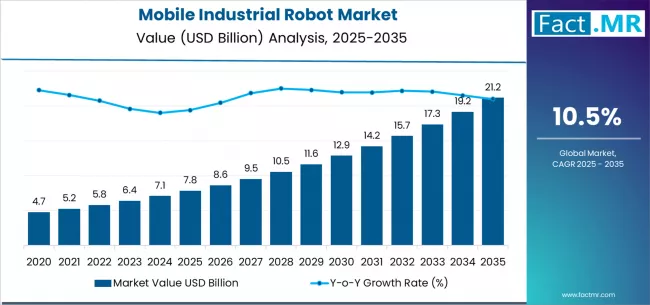
The mobile industrial robot market represents a specialized segment of the global warehouse automation industry. The market shows rapid technological advancement. Consistent demand exists across logistics automation channels. Material handling channels drive growth. Market dynamics are influenced by changing industrial requirements toward flexible automation solutions. Growing interest in autonomous operations management shapes development. Expanding partnerships between robotics manufacturers drive growth. Warehouse operators in developed economies show increased adoption. Emerging economies demonstrate growing demand patterns. Traditional material handling methods continue evolving. Operators seek proven autonomous alternatives. Enhanced efficiency benefits attract logistics users. Reliable navigation characteristics remain essential requirements.
Consumer behavior in the market reflects broader warehouse automation trends. Efficient robotic systems provide functional benefits. Effective systems deliver logistics precision. The market benefits from growing popularity of autonomous solutions. These systems are recognized for sophisticated navigation integration. Technical approach to mobile automation gains acceptance. The versatility of mobile industrial robots supports multiple applications. Standalone robotic devices serve specific needs. Integrated warehouse system components expand market reach. Multiple logistics applications drive demand growth. E-commerce segments show increased adoption patterns.
Regional adoption patterns vary significantly across global markets. North American markets show strong preference for standardized mobile robot implementations. European markets demonstrate similar standardization trends. Asian markets show increasing adoption of advanced autonomous solutions. Conventional material handling systems remain popular in developing regions. The logistics landscape continues evolving with sophisticated products. Quality-controlled mobile robot products gain traction in mainstream applications. Warehouse applications reflect operator willingness to invest in improvements. Proven automation system enhancements attract investment. Performance-oriented features drive adoption decisions.
The competitive environment features established automation companies. Specialized mobile robotics solution providers focus on unique capabilities. Advanced navigation methods drive differentiation. Operational efficiency remains critical for market participants. Product development optimization continues as key factor. Component costs create ongoing challenges. Quality standardization requirements fluctuate regularly. Distribution strategies emphasize multi-channel approaches. Traditional warehouse supply chains combine with direct partnerships. Technical service platforms expand market reach. Supply distribution agreements strengthen customer relationships.
Market consolidation trends indicate acquisition strategies by larger manufacturers. Warehouse automation manufacturers acquire specialized mobile robotics companies. Product portfolio diversification drives acquisition activity. Access to specialized autonomous system segments motivates purchases. Private label development has gained momentum. Logistics companies seek differentiation opportunities. Competitive pricing structures remain important considerations. Specialized mobile robot variants emerge in the market. High-payload options reflect changing warehouse priorities. AI-enabled options create new market opportunities. Innovative robotics system developers benefit from emerging trends. Manufacturing automation enables consistent production scaling. Quality control improvements maintain traditional performance characteristics. Operators expect established performance from robotic system brands.
Between 2025 and 2030, the market projects expansion from USD 7.8 billion to USD 14.3 billion. This results in a value increase of USD 6.5 billion. The increase represents 49.2% of the total forecast growth for the decade. This development phase will be shaped by increasing adoption of autonomous navigation systems. Rising demand for flexible warehouse automation drives growth. Advanced AI integration gains market acceptance. Growing focus on logistics efficiency supports expansion. Enhanced navigation characteristics attract users. Warehouse operators expand robotic capabilities. Growing demand for specialized mobile robot implementations continues. Advanced autonomous options gain popularity. Logistics offerings across e-commerce segments increase.
Mobile Industrial Robot (MIR/AMR) Market Key Takeaways
| Metric | Value |
|---|---|
| Estimated Value (2025E) | USD 7.8 billion |
| Forecast Value (2035F) | USD 21 billion |
| Forecast CAGR (2025-2035) | 10.50% |
From 2030 to 2035, the market is forecast to grow from USD 14.3 billion to USD 21 billion. This adds another USD 6.7 billion. The addition constitutes 50.8% of the overall ten-year expansion. This period is expected to be characterized by expansion of intelligent robotics. Integration of machine learning capabilities continues. Development of specialized mobile robot implementations occurs. Enhanced autonomy profiles gain importance. Extended performance capabilities attract users. Growing adoption of smart logistics will drive demand. Mobile robots with superior AI characteristics gains acceptance. Compatibility with warehouse management systems across logistics operations expands.
Between 2020 and 2025, the market experienced explosive growth. E-commerce expansion drove development. Growing recognition of mobile robots as essential automation tools supported expansion. Labor shortage mitigation programs across warehouses gained momentum. Logistics efficiency applications showed growth. The market developed as operators recognized potential benefits. Mobile robot solutions provide functional advantages. Autonomous navigation capabilities enable convenient automation protocols. Technological advancement in AI systems began development. Efficiency-critical applications emphasize importance of maintaining performance. Consistency in diverse warehouse environments becomes critical.
Why Is the Mobile Industrial Robot Market Expanding Across Global Logistics and Warehouses?
Market expansion is supported by increasing warehouse automation needs. E-commerce growth drives demand. Labor shortage concerns create requirements. Corresponding need for autonomous solutions provides superior efficiency benefits. Flexibility advantages enable enhanced logistics outcomes. Extended compatibility across various warehouse applications drives growth. Healthcare applications show expansion. Modern operators focus on implementing proven robotic systems. Logistics specialists seek effective productivity support. Minimized operational complexity appeals to users. Consistent performance throughout complex warehouse configurations attracts adoption. Diverse logistics environments require reliable solutions. Mobile robots deliver exceptional automation efficacy against traditional alternatives. Advanced warehouse integration capabilities support modern protocols. Essential components for contemporary logistics operations gain acceptance.
Growing focus on logistics flexibility drives demand for mobile automation adoption. Mobile robots support large-scale warehouse requirements. Improved efficiency outcomes attract users. Advanced robotic systems gain acceptance. Operator preference for products combines effective automation support with proven performance. Productivity benefits create opportunities for innovative implementations. Rising influence of e-commerce trends contributes to increased demand. Logistics awareness drives market growth. Mobile robots provide advanced reliability. Seamless warehouse integration appeals to users. Consistent performance across extended operation periods remains important.
Opportunity Pathways - Mobile Industrial Robot (MIR/AMR) Market
The mobile industrial robot market shows potential for rapid growth. Technological advancement continues development. Warehouse operators across North America seek systems delivering exceptional automation quality. Europe shows similar trends. Asia-Pacific markets demonstrate growth potential. Emerging markets seek advanced efficiency capabilities. Reliable navigation options gain acceptance. Mobile robot solutions gain prominence beyond robotic systems. Strategic enablers of warehouse automation expand applications. Advanced autonomous functionality grows in importance.
Rising warehouse automation adoption in Asia-Pacific amplifies demand. Expanding e-commerce initiatives globally support growth. Manufacturers leverage innovations in robotics engineering. Advanced navigation integration gains momentum. Warehouse management technologies advance rapidly.
Pathways like high-performance implementations show promise for strong margin uplift. Specialized robotic platforms demonstrate potential. Advanced automation solutions target premium logistics segments. Geographic expansion captures volume opportunities. Product diversification addresses market needs. Local warehouse preferences become critical factors. Advanced automation adoption drives regional growth. Regulatory support around safety standards provides structural foundation. Robotic efficacy standards gain importance. Automation protocols strengthen market development.
- Pathway A - E-commerce Applications. E-commerce companies require mobile robot solutions with high-performance capabilities. Large fulfillment centers demand advanced navigation profiles for enhanced automation appeal. Premium positioning capabilities attract investment. Robotic system developers creating high-performance platforms with superior autonomous standards command premium pricing. Expected revenue pool: USD 4.2 billion to USD 5.3 billion.
- Pathway B - Specialized Navigation Platforms. Growing demand for specialized autonomous implementations drives market growth. Advanced navigation capabilities attract users. Unique AI features create demand for advanced warehouse capabilities. Specialized logistics integration opportunities exist. Revenue opportunity: USD 3.7 billion to USD 4.6 billion.
- Pathway C - Advanced Automation Solutions. Advanced mobile robot formulations meet specific warehouse requirements. Navigation compatibility requirements grow. Specialized autonomous profiles enable market expansion. Enhanced operator appeal attracts efficiency-focused companies. Revenue lift: USD 3.2 billion to USD 4.0 billion.
- Pathway D - Healthcare Applications. Expanding reach into healthcare facilities creates opportunities. Optimized material transport delivery gains importance. Advanced facility integration capabilities expand. Extended performance capabilities attract users. Operators seek partners supplying integrated solutions with complete robotic functionality. Pool: USD 3.4 billion to USD 4.3 billion.
- Pathway E - Geographic Expansion & Local Manufacturing. Strong growth in APAC markets continues. China shows particular potential. India demonstrates expansion opportunities. Southeast Asia markets develop rapidly. Local manufacturing lowers costs. Supply complexity reduction enables faster response to regional preferences. Expected upside: USD 3.6 billion to USD 4.5 billion.
- Pathway F - Collaborative Robotics Development. Increasing demand for human-robot collaboration grows. Application-specific functionality gains importance. Specialized autonomous profiles with validated performance characteristics attract logistics companies. Revenue opportunity: USD 2.7 billion to USD 3.4 billion.
- Pathway G - AI Integration. Developing comprehensive intelligent solutions creates differentiation. Digital platform compatibility services expand applications. Robotic programs address specialized requirements for warehouse operators. Logistics companies show growing demand from smart automation services. Pool: USD 2.4 billion to USD 3.0 billion.
How Is the Mobile Industrial Robot Market Segmented by Payload, Navigation, and End Use?
The market is segmented by payload, navigation, end-use sector, and region. By payload, the market divides into ≤500 kg, 500-1,500 kg, and >1,500 kg categories. By navigation, it covers LiDAR/SLAM, QR/markers, and Magnetic/inductive segments. By end-use sector, it includes E-commerce & warehouses, Automotive, and Healthcare/others categories. Regionally, the market spans North America, Europe, Asia-Pacific, Latin America, and Middle East & Africa.
By Payload, the ≤500 kg Segment Accounts for 57% Market Share
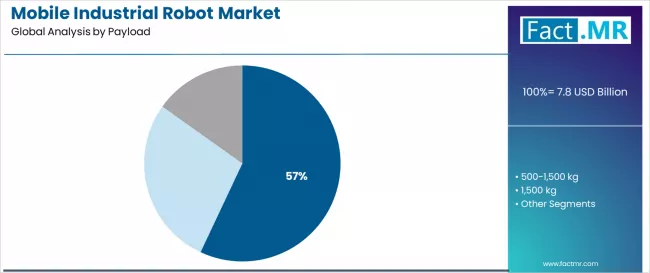
The ≤500 kg segment projects to account for 57% of the market in 2025. This reaffirms its position as the leading payload category. Warehouse operators utilize lightweight implementations for superior handling standards. Logistics system integrators prefer these systems when operating across diverse facility platforms. Excellent maneuverability properties attract users. Widespread acceptance ranges from basic material handling operations to critical warehouse processing. Lightweight robot technology's advanced navigation methods address operator requirements for efficient logistics solutions. Complex warehouse environments benefit from these capabilities.
This payload segment forms the foundation of modern warehouse automation adoption patterns. The implementation offers greatest operational flexibility. Established market demand exists across multiple logistics categories. Warehouse segments show strong adoption. Operator investments in lightweight standardization continue. Navigation efficiency improvements strengthen adoption among warehouse operators. Logistics companies prioritize flexibility with operational efficiency. Lightweight implementations align with functionality preferences. Performance expectations make these systems central components of comprehensive warehouse automation strategies.
By Navigation, the LiDAR/SLAM Segment Accounts for 48% Market Share
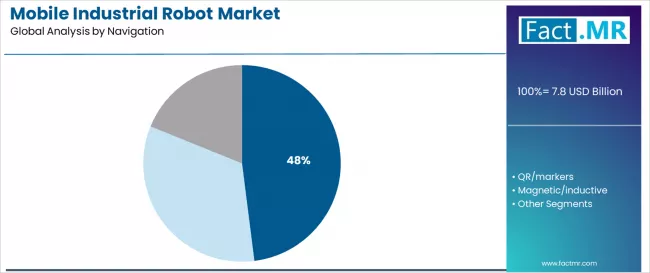
LiDAR/SLAM navigation applications project to represent 48% of mobile robot demand in 2025. This underscores their critical role as primary navigation technology for autonomous systems. Warehouse operations use these systems across material handling applications. Distribution operations benefit from navigation capabilities. Industrial warehouse applications show strong adoption. Operators prefer this navigation type for exceptional accuracy characteristics. Advanced mapping options appeal to users. Ability to handle diverse facility layouts while ensuring consistent navigation performance attracts adoption. Various warehouse platforms benefit from navigation methods. Essential technology for modern autonomous operations offers functional advantages. Precision benefits remain important considerations.
The segment gains support from continuous innovation in navigation technologies. Growing availability of specialized implementations enables diverse warehouse requirements. Enhanced mapping capabilities expand applications. Extended accuracy capabilities attract investment. Operators invest in advanced navigation systems supporting large-scale warehouse integration. Operational development drives growth. Warehouse automation trends become prevalent. Operator precision awareness increases acceptance. LiDAR applications continue representing major implementation markets. Advanced warehouse utilization strategies gain support. Navigation integration initiatives expand market reach.
By End-Use Sector, the E-commerce & Warehouses Segment Accounts for 44% Market Share
E-commerce & warehouse applications project to represent 44% of mobile robot demand in 2025. This demonstrates significance as primary deployment sector for autonomous systems. Fulfillment operations benefit from automation advantages. Distribution facilities show strong adoption. E-commerce operators utilize mobile robots for exceptional efficiency characteristics. Proven reliability in demanding environments attracts users. Ability to maintain consistent robotic performance across diverse operational conditions appeals to operators. The segment's dominance reflects critical nature of automation in e-commerce logistics. Industry commitment to efficiency standards drives adoption.
The e-commerce sector drives innovation in mobile robotics technology through demanding operational requirements. Stringent performance regulations exist. Operators invest heavily in advanced robotic systems ensuring operational continuity. Efficiency compliance requirements grow. Increasing focus on logistics speed supports market position. Automation management initiatives expand. E-commerce applications maintain position as largest end-use segment. Technological advancement initiatives continue. Performance optimization across mobile robot markets gains momentum.
What Are the Major Drivers, Restraints, and Emerging Trends Influencing the Mobile Industrial Robot Market?
The mobile industrial robot market advances rapidly due to increasing e-commerce expansion driven by online shopping growth. Labor shortage programs support development. Growing adoption of autonomous systems provides superior navigation characteristics. Efficiency benefits enable enhanced logistics outcomes across diverse warehouse applications. Healthcare applications expand market reach. The market faces challenges including high initial investment costs. Complex integration requirements create implementation barriers. Specialized maintenance needs grow. Navigation programs become more sophisticated. Innovation in collaborative robotics continues influencing product development. Cost-effective automation methods drive market expansion patterns.
Expansion of E-commerce and Warehouse Automation
Growing e-commerce sectors enable market development. Advanced logistics management capabilities expand applications. Warehouse efficiency awareness drives equipment manufacturers to produce advanced mobile robot solutions. Superior productivity positioning attracts users. Enhanced reliability profiles gain acceptance. Seamless integration functionalities expand market reach. Advanced robotic systems provide improved operational outcomes. More efficient warehouse workflows develop. Reliable performance across various logistics applications continues. Operating conditions improve with advanced systems. Developers recognize competitive advantages of robotic solution integration capabilities. Market differentiation opportunities expand. Automation positioning becomes increasingly important.
Integration of AI and Autonomous Navigation Technologies
Modern mobile robot providers incorporate advanced artificial intelligence technology. Warehouse system integration expands capabilities. Sophisticated robotic solutions enhance product appeal. Intelligent navigation features develop rapidly. Value-added solutions for logistics customers gain acceptance. These technologies improve operational efficiency. New market opportunities emerge including predictive maintenance. Optimized automation enhancement capabilities expand. Enhanced autonomy characteristics attract users. Advanced AI integration allows developers supporting comprehensive warehouse technologies. Market expansion beyond traditional robotic approaches continues.
Development of Collaborative Robotics and Safety Systems
Growing adoption of collaborative solutions enables market development. Advanced safety management capabilities expand applications. Human-robot interaction awareness drives manufacturers to produce advanced mobile robot solutions. Superior safety positioning attracts users. Enhanced cooperation profiles gain acceptance. Seamless integration functionalities expand market reach. Advanced collaborative systems provide improved operational outcomes. More efficient human-robot workflows develop. Reliable performance across various collaborative applications continues. Operating conditions improve with advanced systems. Developers recognize competitive advantages of collaborative solution integration capabilities. Market differentiation opportunities expand. Safety positioning becomes increasingly important.
How Are Leading Countries Shaping Growth Opportunities in the Mobile Industrial Robot Market?
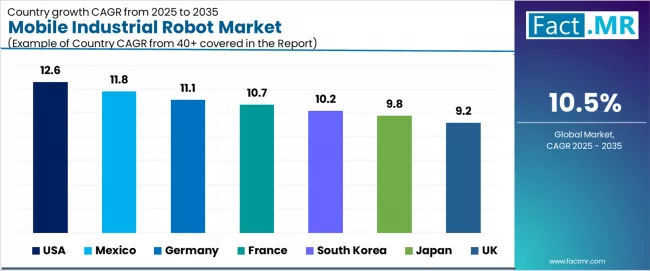
| Country | CAGR (2025-2035) |
|---|---|
| USA | 12.6% |
| Mexico | 11.8% |
| Germany | 11.1% |
| France | 10.7% |
| South Korea | 10.2% |
| Japan | 9.8% |
| UK | 9.2% |
The market experiences exceptional growth globally. The United States leads at 12.6% CAGR through 2035. Expanding e-commerce infrastructure drives growth. Growing warehouse automation programs support development. Significant investment in logistics advancement continues. Mexico follows at 11.8%. Increasing manufacturing automation supports growth. Growing logistics modernization patterns develop. Expanding warehouse infrastructure drives demand. Germany shows growth at 11.1%. Engineering leadership emphasizes development. Robotics technology advancement continues. France records 10.7% growth. Expanding logistics capabilities support market development. Automation system integration modernization continues. South Korea demonstrates 10.2% growth. Advanced robotics technology development occurs. Manufacturing automation adoption trends drive market expansion. Japan exhibits 9.8% growth. Robotics technology innovation emphasizes development. Industrial advancement continues. The UK shows 9.2% growth. Quality control initiatives support development. Technology-focused logistics patterns continue.
The report covers in-depth analysis of 40+ countries, top-performing countries receive highlighting below.
United States Leads Global Market Growth with E-commerce Excellence
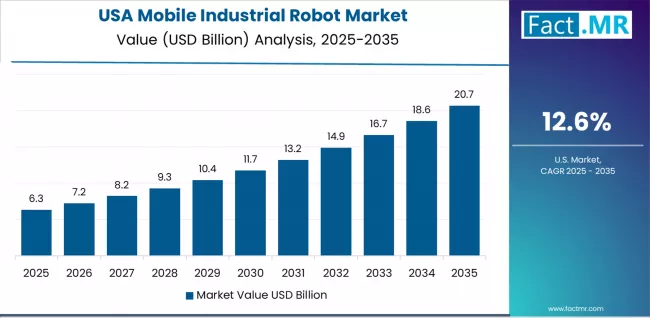
The United States projects exceptional growth with 12.6% CAGR through 2035. Expanding e-commerce capacity drives development. Rapidly growing warehouse automation programs receive government initiative support promoting logistics development. The country's strong position in e-commerce technology supports growth. Increasing investment in robotic infrastructure creates substantial demand for advanced implementations. Major e-commerce companies establish comprehensive automation capabilities. Robotic system companies serve domestic logistics demand. Expanding fulfillment markets drive growth.
The US leads global market growth due to its massive e-commerce sector and advanced warehouse automation. The country benefits from Amazon's leadership driving industry automation standards. Major factors include rapid e-commerce growth requiring efficient fulfillment systems. Labor shortages driving warehouse automation necessity. Major retailers like Walmart investing in robotic systems. Strong venture capital funding for robotics startups. Government support for advanced manufacturing automation. High labor costs making automation economically attractive. Advanced logistics infrastructure supporting robotic deployment. Strong focus on supply chain efficiency requiring automation.
Government support for logistics modernization initiatives drives demand for advanced robotic systems. Major distribution regions benefit from development. Fulfillment centers across the country show expansion. Strong automation technology growth occurs. Expanding network of automation-focused operators supports rapid adoption. Warehouse operators seek advanced robotic capabilities. Integrated automation technologies gain acceptance.
Mexico Demonstrates Strong Logistics Growth with Industrial Expansion
Mexico expands at 11.8% CAGR. The country's growing logistics sector supports development. Expanding manufacturing capacity drives growth. Increasing adoption of robotic technologies continues. Country initiatives promoting logistics modernization create demand. Growing automation awareness drives requirements for quality-controlled robotic systems. International logistics providers establish extensive capabilities. Domestic warehouse companies address growing demand for advanced automation solutions.
Mexico shows exceptional growth potential driven by nearshoring trends and manufacturing expansion. The country experiences rapid logistics growth supported by trade benefits. Key factors include growing manufacturing requiring automated material handling. Expanding e-commerce market needing fulfillment automation. Rising foreign direct investment in automated facilities. Government initiatives to modernize logistics capabilities. Growing adoption of international automation standards. Strategic location for serving North American markets. Increasing focus on logistics efficiency. Strong industrial operations adopting robotic technologies.
Rising logistics requirements create opportunities for mobile robot adoption. Metropolitan distribution centers show growth. Progressive operators invest in modern robotic facilities. Major logistics regions expand operations. Growing focus on automation integration drives adoption. Robotic features appeal to operators seeking enhanced operational capabilities. Advanced automation delivery experiences attract investment.
Germany Demonstrates Engineering Leadership with Logistics Innovation
Germany expands at 11.1% CAGR. The country's engineering heritage supports development. Strong focus on robotics technology continues. Robust demand for advanced robotic systems exists in logistics applications. Manufacturing applications drive growth. The nation's mature industrial sector supports development. Technology-focused operations drive sophisticated implementations throughout the robotics industry. Leading manufacturers invest extensively in technology development. Advanced robotic methods serve domestic markets. International markets benefit from German expertise.
Germany maintains its position as Europe's logistics automation leader with strong Industry 4.0 initiatives. The country's advanced manufacturing culture drives warehouse automation adoption. Growth drivers include strong logistics sector requiring efficient automation. Advanced e-commerce market needing robotic solutions. Industry 4.0 government initiative promoting smart logistics. Advanced engineering education producing robotics expertise. High labor costs encouraging automation adoption. Excellent research institutions developing robotic technologies. Strong focus on precision logistics requiring robotic accuracy. Well-developed automation supply chain supporting deployment.
Rising demand for high-performance robotic technologies creates requirements for sophisticated solutions. Exceptional automation capabilities appeal to quality-conscious operators. Enhanced logistics experiences gain acceptance. Advanced robotic methods attract investment. Strong engineering tradition supports growth. Growing investment in robotics technologies drives adoption. Quality platforms with advanced development methods appeal to users. Enhanced robotic profiles across logistics operations expand in major distribution regions.
France Focuses on Logistics Modernization and Robotics Integration
France grows at 10.7% CAGR. The country's logistics modernization sector drives development. Growing robotics integration programs support expansion. Increasing investment in automation development continues. France's logistics infrastructure supports market growth. Commitment to technological advancement drives demand for diverse robotic solutions. Multiple logistics segments benefit from development. Operators establish comprehensive robotics capabilities. Growing domestic market drives development. Expanding logistics opportunities support growth.
France demonstrates strong growth supported by government digitalization initiatives and logistics industry modernization. Key factors include strong retail sector requiring automated fulfillment. Advanced automotive industry needing robotic logistics. Government France 2030 investment plan supporting logistics robotics. Growing focus on sustainable logistics requiring efficient automation. Strategic position as European distribution hub driving robotics investment. Increasing focus on operational efficiency in logistics competitiveness. Strong e-commerce sector requiring automated solutions. Growing adoption of smart logistics concepts supporting robotics technology.
Strong logistics expansion drives adoption of integrated robotic systems. Superior automation capabilities appeal to users. Advanced integration attracts large operators. Progressive logistics companies invest in systems. Growing robotics diversity supports market expansion. Increasing logistics adoption drives advanced implementations. Seamless robotic profiles appeal to users. Modern automation delivery throughout the country's logistics regions gains acceptance.
How Are Regional Automation Initiatives Reinforcing Market Evolution Across Europe?
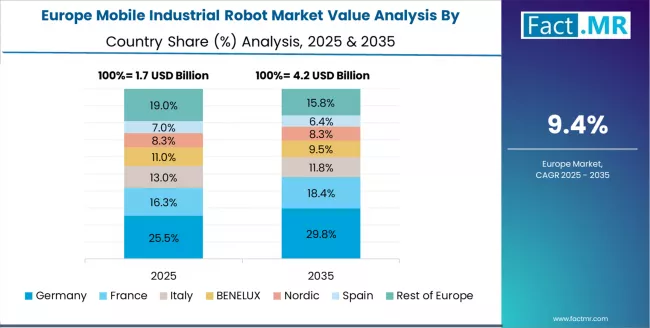
The mobile industrial robot market in Europe projects growth from USD 2.3 billion in 2025 to USD 6.2 billion by 2035. This registers CAGR of 11.0% over the forecast period. Germany expects to maintain leadership position with 33.0% market share in 2025. This declines slightly to 32.7% by 2035. Support comes from strong engineering culture. Sophisticated robotics manufacturing capabilities continue. Comprehensive logistics sector serves diverse applications across Europe.
France follows with 25.7% share in 2025. This projects to reach 26.0% by 2035. Robust demand for advanced robotics technologies in logistics applications drives growth. Automation modernization programs support development. Robotics markets benefit from established logistics infrastructure. Technology integration expertise continues. The United Kingdom holds 19.6% share in 2025. This expects to reach 19.8% by 2035. Strong robotics technology sector supports growth. Growing logistics automation activities drive development. Italy commands 12.2% share in 2025. This projects to reach 12.4% by 2035. Spain accounts for 7.0% in 2025. This expects to reach 7.1% by 2035. Rest of Europe region anticipates maintaining momentum. Collective share moves from 2.5% to 2.0% by 2035. Increasing robotics modernization in Eastern Europe drives development. Growing technology penetration in Nordic countries implementing advanced logistics programs supports expansion.
How Is Robotics Innovation Advancing Logistics Efficiency in Japan?
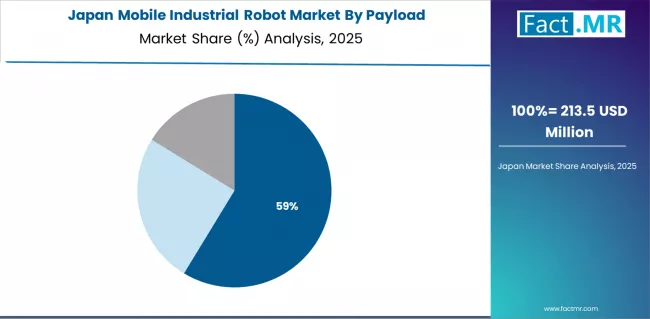
Japan expands at 9.8% CAGR. The country's robotics system excellence initiatives support development. Growing robotics technology sector continues expansion. Strategic focus on advanced logistics development drives market growth. Japan's advanced quality control capabilities support demand. Integrated robotic systems drive demand for high-quality platforms in logistics operations. Manufacturing automation applications grow. Advanced technology applications expand market reach. Leading manufacturers invest in specialized capabilities. Technology-focused logistics requirements gain attention. Robotics industries demand sophisticated solutions.
Japan shows strong growth supported by robotics leadership and advanced logistics culture. Growth factors include major robotics companies developing mobile platforms. Strong focus on quality control and continuous improvement (kaizen). Advanced manufacturing industry requiring automated material handling. Aging workforce creating labor shortages driving robotics adoption. Leadership in robotics technology development and manufacturing. Focus on precision logistics requiring robotic accuracy. High labor costs encouraging automation investment. Advanced logistics processes requiring sophisticated robotics. Strong industrial automation heritage supporting market development.
Quality control advancement creates requirements for specialized solutions. Superior quality integration appeals to users. Exceptional robotic capabilities attract investment. Advanced automation features gain acceptance among quality-conscious logistics operations. Logistics operators seek sophisticated systems. Strong position in robotics technology innovation supports adoption. Advanced systems with validated robotic characteristics gain acceptance. Quality integration capabilities throughout the country's logistics technology sector expand.
How Are Technology Integration Programs Fueling Market Growth in South Korea?
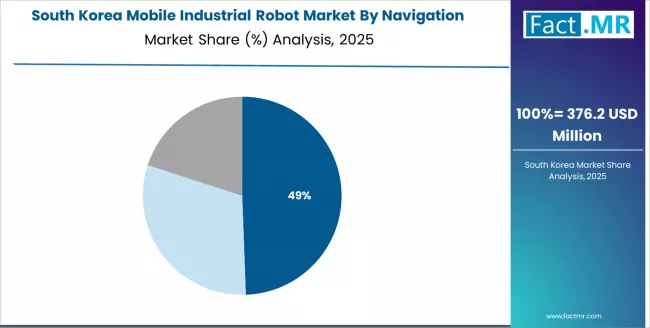
South Korea grows at 10.2% CAGR. The country's technology integration initiatives drive development. Expanding manufacturing sector supports growth. Strategic focus on robotics development continues. South Korea's advanced manufacturing capabilities support market expansion. Commitment to manufacturing modernization drives investment in specialized technologies. Major manufacturing regions benefit from development. Industry leaders establish comprehensive technology integration systems. Domestic manufacturing operations benefit from advanced robotic applications.
South Korea exhibits strong growth driven by advanced electronics manufacturing and logistics automation initiatives. Key drivers include Samsung and LG requiring sophisticated logistics automation. Strong automotive sector needing automated material handling. Government Korean New Deal supporting digital transformation in logistics. Advanced shipbuilding industry requiring large-scale robotic systems. High technology adoption culture among manufacturers. Rising labor costs driving automation necessity. Government Industry 4.0 initiatives providing robotics funding. Strong electronics industry expertise applied to robotic manufacturing. Growing focus on export competitiveness through automation technology.
Innovations in robotics platforms create demand for advanced implementations. Technology integration capabilities attract users. Exceptional robotic properties appeal to progressive operators. Enhanced technology differentiation gains acceptance. Operational appeal drives adoption. Growing logistics adoption supports market development. Increasing focus on robotics innovation drives advanced platform adoption. Integrated robotic delivery gains acceptance. Logistics optimization across industrial enterprises throughout the country expands market reach.
United Kingdom Emphasizes Advanced Technology Development and Logistics Trends
The UK expands at 9.2% CAGR. The country's advanced robotics technology sector supports development. Strategic focus on logistics solutions continues. Established automation capabilities drive growth. The UK's robotics system innovation leadership supports market expansion. Automation technology integration drives demand for specialized implementations in logistics applications. Industrial operations show growth. Advanced efficiency products expand market reach. Operators invest in comprehensive robotics development serving domestic specialty markets. International logistics applications benefit from development.
The UK shows consistent growth driven by advanced logistics initiatives and automation adoption. Strong e-commerce sector requiring automated fulfillment systems. Key factors include government support for logistics automation through Industrial Strategy. Growing retail sector requiring robotic warehouse systems. Focus on high-value logistics through automation technology. Strong research institutions developing robotics innovations. Post-Brexit focus on logistics efficiency driving automation. Growing labor shortages encouraging robotic adoption. Advanced logistics hubs requiring sophisticated automation. Strong position in collaborative robotics development.
Logistics optimization and robotics technology advancement create opportunities for specialized automation adoption in advanced systems. Warehouse services benefit from development. Technology-focused logistics operations among leading enterprises gain acceptance. Growing focus on advanced robotic delivery drives adoption. Automation features support quality implementations with enhanced technology profiles. Integrated robotics management throughout the country's logistics technology sector expands market reach.
How Competitive Is the Global Mobile Industrial Robot Market and What Shapes Its Strategic Landscape?
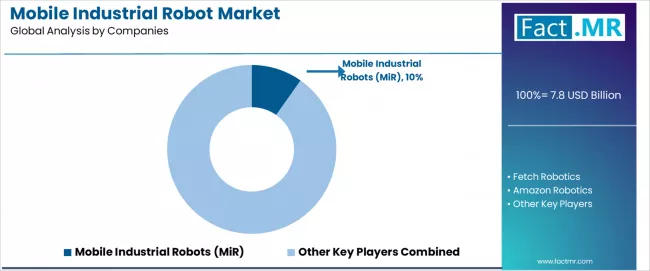
The market demonstrates intense competition among established automation companies, specialized mobile robotics developers, and integrated warehouse solution providers. Companies invest heavily in navigation technology research, autonomy optimization, and advanced AI system development to deliver high-performance, reliable, and cost-competitive mobile robot solutions. Innovation in artificial intelligence integration, collaborative robotics capabilities, and warehouse management system connectivity remains central to strengthening market position and competitive advantage across global markets.
Mobile Industrial Robots (MiR) leads the market with a 9.8% market share, offering comprehensive autonomous mobile robot solutions including quality navigation platforms and advanced AI systems with particular focus on warehouse automation and industrial material handling applications. The company's strength lies in collaborative robotics and safety technology, providing integrated solutions that enable safe human-robot collaboration. Fetch Robotics provides specialized logistics capabilities with strong focus on advanced mobile robot implementations and warehouse automation solutions, particularly serving e-commerce and fulfillment markets. Amazon Robotics delivers comprehensive warehouse automation services with focus on e-commerce platforms and large-scale fulfillment applications, combining mobile robots with warehouse management integration.
ABB specializes in advanced automation devices and industrial implementations for logistics applications, expanding market reach through comprehensive automation solutions. KION Group focuses on material handling integration and innovative warehouse technology solutions. Seegrid offers advanced vision-guided mobile robots with focus on industrial material transport applications, serving manufacturing and distribution sectors. The competitive environment also includes significant players like Geek+, OTOKAR, GreyOrange, and Dematic, each focusing on specific market segments and technological specializations in autonomous mobile robotics and warehouse automation systems.
The competitive landscape reflects ongoing innovation as companies develop next-generation autonomous systems to address evolving logistics needs. Companies focus on developing integrated solutions that combine mobile robot technology with artificial intelligence, machine learning capabilities, and warehouse management system integration to differentiate offerings and capture higher-value market segments. Strategic partnerships between robot manufacturers and end-users drive application development and market expansion, while increasing focus on collaborative robotics and safety systems creates opportunities for technology leaders to develop more intuitive and safer robotic solutions for shared workspace environments.
Who Are the Leading Companies Driving Innovation in the Mobile Industrial Robot Market?
- Mobile Industrial Robots (MiR)
- Fetch Robotics
- Amazon Robotics
- ABB
- KION Group
- Seegrid
- Geek+
- OTOKAR
- GreyOrange
- Dematic
What Defines the Analytical Scope and Research Framework of the Mobile Industrial Robot Market Report?
| Item | Value |
|---|---|
| Quantitative Units | USD 7.8 billion |
| Payload | ≤500 kg; 500-1,500 kg; >1,500 kg |
| Navigation | LiDAR/SLAM; QR/markers; Magnetic/inductive |
| End-Use Sector | E-commerce & warehouses; Automotive; Healthcare/others |
| Regions Covered | North America; Europe; Asia-Pacific; Latin America; Middle East & Africa |
| Countries Covered | United States; Germany; France; United Kingdom; Japan; South Korea; Mexico; and 40+ additional countries |
| Key Companies Profiled | Mobile Industrial Robots (MiR); Fetch Robotics; Amazon Robotics; ABB; KION Group; Seegrid |
| Additional Attributes | Dollar sales by payload and navigation category; regional demand trends; competitive landscape; technological advancements in autonomous robotics; advanced navigation development; AI innovation; warehouse integration protocols |
How Is the Mobile Industrial Robot Market Structured Across Payload, Navigation, End Use, and Region?
-
Payload :
- ≤500 kg
- 500-1,500 kg
- 1,500 kg
-
Navigation :
- LiDAR/SLAM
- QR/markers
- Magnetic/inductive
-
End-Use Sector :
- E-commerce & warehouses
- Automotive
- Healthcare/others
-
Region :
-
North America
- United States
- Canada
- Mexico
-
Europe
- Germany
- United Kingdom
- France
- Italy
- Spain
- Rest of Europe
-
Asia-Pacific
- China
- Japan
- South Korea
- India
- Australia
- Rest of Asia-Pacific
-
Latin America
- Brazil
- Argentina
- Rest of Latin America
-
Middle East & Africa
- Saudi Arabia
- UAE
- South Africa
- Rest of Middle East & Africa
-
Table of Content
- Executive Summary
- Global Market Outlook
- Demand to side Trends
- Supply to side Trends
- Technology Roadmap Analysis
- Analysis and Recommendations
- Market Overview
- Market Coverage / Taxonomy
- Market Definition / Scope / Limitations
- Market Background
- Market Dynamics
- Drivers
- Restraints
- Opportunity
- Trends
- Scenario Forecast
- Demand in Optimistic Scenario
- Demand in Likely Scenario
- Demand in Conservative Scenario
- Opportunity Map Analysis
- Product Life Cycle Analysis
- Supply Chain Analysis
- Investment Feasibility Matrix
- Value Chain Analysis
- PESTLE and Porter’s Analysis
- Regulatory Landscape
- Regional Parent Market Outlook
- Production and Consumption Statistics
- Import and Export Statistics
- Market Dynamics
- Global Market Analysis 2020 to 2024 and Forecast, 2025 to 2035
- Historical Market Size Value (USD Million) Analysis, 2020 to 2024
- Current and Future Market Size Value (USD Million) Projections, 2025 to 2035
- Y to o to Y Growth Trend Analysis
- Absolute $ Opportunity Analysis
- Global Market Pricing Analysis 2020 to 2024 and Forecast 2025 to 2035
- Global Market Analysis 2020 to 2024 and Forecast 2025 to 2035, By Payload
- Introduction / Key Findings
- Historical Market Size Value (USD Million) Analysis By Payload , 2020 to 2024
- Current and Future Market Size Value (USD Million) Analysis and Forecast By Payload , 2025 to 2035
- ≤500 kg
- 500-1,500 kg
- 1,500 kg
- Y to o to Y Growth Trend Analysis By Payload , 2020 to 2024
- Absolute $ Opportunity Analysis By Payload , 2025 to 2035
- Global Market Analysis 2020 to 2024 and Forecast 2025 to 2035, By Navigation
- Introduction / Key Findings
- Historical Market Size Value (USD Million) Analysis By Navigation, 2020 to 2024
- Current and Future Market Size Value (USD Million) Analysis and Forecast By Navigation, 2025 to 2035
- LiDAR/SLAM
- QR/markers
- Magnetic/inductive
- Y to o to Y Growth Trend Analysis By Navigation, 2020 to 2024
- Absolute $ Opportunity Analysis By Navigation, 2025 to 2035
- Global Market Analysis 2020 to 2024 and Forecast 2025 to 2035, By Region
- Introduction
- Historical Market Size Value (USD Million) Analysis By Region, 2020 to 2024
- Current Market Size Value (USD Million) Analysis and Forecast By Region, 2025 to 2035
- North America
- Latin America
- Western Europe
- Eastern Europe
- East Asia
- South Asia and Pacific
- Middle East & Africa
- Market Attractiveness Analysis By Region
- North America Market Analysis 2020 to 2024 and Forecast 2025 to 2035, By Country
- Historical Market Size Value (USD Million) Trend Analysis By Market Taxonomy, 2020 to 2024
- Market Size Value (USD Million) Forecast By Market Taxonomy, 2025 to 2035
- By Country
- USA
- Canada
- Mexico
- By Payload
- By Navigation
- By Country
- Market Attractiveness Analysis
- By Country
- By Payload
- By Navigation
- Key Takeaways
- Latin America Market Analysis 2020 to 2024 and Forecast 2025 to 2035, By Country
- Historical Market Size Value (USD Million) Trend Analysis By Market Taxonomy, 2020 to 2024
- Market Size Value (USD Million) Forecast By Market Taxonomy, 2025 to 2035
- By Country
- Brazil
- Chile
- Rest of Latin America
- By Payload
- By Navigation
- By Country
- Market Attractiveness Analysis
- By Country
- By Payload
- By Navigation
- Key Takeaways
- Western Europe Market Analysis 2020 to 2024 and Forecast 2025 to 2035, By Country
- Historical Market Size Value (USD Million) Trend Analysis By Market Taxonomy, 2020 to 2024
- Market Size Value (USD Million) Forecast By Market Taxonomy, 2025 to 2035
- By Country
- Germany
- UK
- Italy
- Spain
- France
- Nordic
- BENELUX
- Rest of Western Europe
- By Payload
- By Navigation
- By Country
- Market Attractiveness Analysis
- By Country
- By Payload
- By Navigation
- Key Takeaways
- Eastern Europe Market Analysis 2020 to 2024 and Forecast 2025 to 2035, By Country
- Historical Market Size Value (USD Million) Trend Analysis By Market Taxonomy, 2020 to 2024
- Market Size Value (USD Million) Forecast By Market Taxonomy, 2025 to 2035
- By Country
- Russia
- Poland
- Hungary
- Balkan & Baltic
- Rest of Eastern Europe
- By Payload
- By Navigation
- By Country
- Market Attractiveness Analysis
- By Country
- By Payload
- By Navigation
- Key Takeaways
- East Asia Market Analysis 2020 to 2024 and Forecast 2025 to 2035, By Country
- Historical Market Size Value (USD Million) Trend Analysis By Market Taxonomy, 2020 to 2024
- Market Size Value (USD Million) Forecast By Market Taxonomy, 2025 to 2035
- By Country
- China
- Japan
- South Korea
- By Payload
- By Navigation
- By Country
- Market Attractiveness Analysis
- By Country
- By Payload
- By Navigation
- Key Takeaways
- South Asia and Pacific Market Analysis 2020 to 2024 and Forecast 2025 to 2035, By Country
- Historical Market Size Value (USD Million) Trend Analysis By Market Taxonomy, 2020 to 2024
- Market Size Value (USD Million) Forecast By Market Taxonomy, 2025 to 2035
- By Country
- India
- ASEAN
- Australia & New Zealand
- Rest of South Asia and Pacific
- By Payload
- By Navigation
- By Country
- Market Attractiveness Analysis
- By Country
- By Payload
- By Navigation
- Key Takeaways
- Middle East & Africa Market Analysis 2020 to 2024 and Forecast 2025 to 2035, By Country
- Historical Market Size Value (USD Million) Trend Analysis By Market Taxonomy, 2020 to 2024
- Market Size Value (USD Million) Forecast By Market Taxonomy, 2025 to 2035
- By Country
- Kingdom of Saudi Arabia
- Other GCC Countries
- Turkiye
- South Africa
- Other African Union
- Rest of Middle East & Africa
- By Payload
- By Navigation
- By Country
- Market Attractiveness Analysis
- By Country
- By Payload
- By Navigation
- Key Takeaways
- Key Countries Market Analysis
- USA
- Pricing Analysis
- Market Share Analysis, 2024
- By Payload
- By Navigation
- Canada
- Pricing Analysis
- Market Share Analysis, 2024
- By Payload
- By Navigation
- Mexico
- Pricing Analysis
- Market Share Analysis, 2024
- By Payload
- By Navigation
- Brazil
- Pricing Analysis
- Market Share Analysis, 2024
- By Payload
- By Navigation
- Chile
- Pricing Analysis
- Market Share Analysis, 2024
- By Payload
- By Navigation
- Germany
- Pricing Analysis
- Market Share Analysis, 2024
- By Payload
- By Navigation
- UK
- Pricing Analysis
- Market Share Analysis, 2024
- By Payload
- By Navigation
- Italy
- Pricing Analysis
- Market Share Analysis, 2024
- By Payload
- By Navigation
- Spain
- Pricing Analysis
- Market Share Analysis, 2024
- By Payload
- By Navigation
- France
- Pricing Analysis
- Market Share Analysis, 2024
- By Payload
- By Navigation
- India
- Pricing Analysis
- Market Share Analysis, 2024
- By Payload
- By Navigation
- ASEAN
- Pricing Analysis
- Market Share Analysis, 2024
- By Payload
- By Navigation
- Australia & New Zealand
- Pricing Analysis
- Market Share Analysis, 2024
- By Payload
- By Navigation
- China
- Pricing Analysis
- Market Share Analysis, 2024
- By Payload
- By Navigation
- Japan
- Pricing Analysis
- Market Share Analysis, 2024
- By Payload
- By Navigation
- South Korea
- Pricing Analysis
- Market Share Analysis, 2024
- By Payload
- By Navigation
- Russia
- Pricing Analysis
- Market Share Analysis, 2024
- By Payload
- By Navigation
- Poland
- Pricing Analysis
- Market Share Analysis, 2024
- By Payload
- By Navigation
- Hungary
- Pricing Analysis
- Market Share Analysis, 2024
- By Payload
- By Navigation
- Kingdom of Saudi Arabia
- Pricing Analysis
- Market Share Analysis, 2024
- By Payload
- By Navigation
- Turkiye
- Pricing Analysis
- Market Share Analysis, 2024
- By Payload
- By Navigation
- South Africa
- Pricing Analysis
- Market Share Analysis, 2024
- By Payload
- By Navigation
- USA
- Market Structure Analysis
- Competition Dashboard
- Competition Benchmarking
- Market Share Analysis of Top Players
- By Regional
- By Payload
- By Navigation
- Competition Analysis
- Competition Deep Dive
- Mobile Industrial Robots (MiR)
- Overview
- Product Portfolio
- Profitability by Market Segments (Product/Age /Sales Channel/Region)
- Sales Footprint
- Strategy Overview
- Marketing Strategy
- Product Strategy
- Channel Strategy
- Fetch Robotics
- Amazon Robotics
- ABB
- KION Group
- Seegrid
- Geek+
- OTOKAR
- GreyOrange
- Dematic
- Mobile Industrial Robots (MiR)
- Competition Deep Dive
- Assumptions & Acronyms Used
- Research Methodology
List Of Table
- Table 1: Global Market Value (USD Million) Forecast by Region, 2020 to 2035
- Table 2: Global Market Value (USD Million) Forecast by Payload , 2020 to 2035
- Table 3: Global Market Value (USD Million) Forecast by Navigation, 2020 to 2035
- Table 4: North America Market Value (USD Million) Forecast by Country, 2020 to 2035
- Table 5: North America Market Value (USD Million) Forecast by Payload , 2020 to 2035
- Table 6: North America Market Value (USD Million) Forecast by Navigation, 2020 to 2035
- Table 7: Latin America Market Value (USD Million) Forecast by Country, 2020 to 2035
- Table 8: Latin America Market Value (USD Million) Forecast by Payload , 2020 to 2035
- Table 9: Latin America Market Value (USD Million) Forecast by Navigation, 2020 to 2035
- Table 10: Western Europe Market Value (USD Million) Forecast by Country, 2020 to 2035
- Table 11: Western Europe Market Value (USD Million) Forecast by Payload , 2020 to 2035
- Table 12: Western Europe Market Value (USD Million) Forecast by Navigation, 2020 to 2035
- Table 13: Eastern Europe Market Value (USD Million) Forecast by Country, 2020 to 2035
- Table 14: Eastern Europe Market Value (USD Million) Forecast by Payload , 2020 to 2035
- Table 15: Eastern Europe Market Value (USD Million) Forecast by Navigation, 2020 to 2035
- Table 16: East Asia Market Value (USD Million) Forecast by Country, 2020 to 2035
- Table 17: East Asia Market Value (USD Million) Forecast by Payload , 2020 to 2035
- Table 18: East Asia Market Value (USD Million) Forecast by Navigation, 2020 to 2035
- Table 19: South Asia and Pacific Market Value (USD Million) Forecast by Country, 2020 to 2035
- Table 20: South Asia and Pacific Market Value (USD Million) Forecast by Payload , 2020 to 2035
- Table 21: South Asia and Pacific Market Value (USD Million) Forecast by Navigation, 2020 to 2035
- Table 22: Middle East & Africa Market Value (USD Million) Forecast by Country, 2020 to 2035
- Table 23: Middle East & Africa Market Value (USD Million) Forecast by Payload , 2020 to 2035
- Table 24: Middle East & Africa Market Value (USD Million) Forecast by Navigation, 2020 to 2035
List Of Figures
- Figure 1: Global Market Pricing Analysis
- Figure 2: Global Market Value (USD Million) Forecast 2020-2035
- Figure 3: Global Market Value Share and BPS Analysis by Payload , 2025 and 2035
- Figure 4: Global Market Y to o to Y Growth Comparison by Payload , 2025-2035
- Figure 5: Global Market Attractiveness Analysis by Payload
- Figure 6: Global Market Value Share and BPS Analysis by Navigation, 2025 and 2035
- Figure 7: Global Market Y to o to Y Growth Comparison by Navigation, 2025-2035
- Figure 8: Global Market Attractiveness Analysis by Navigation
- Figure 9: Global Market Value (USD Million) Share and BPS Analysis by Region, 2025 and 2035
- Figure 10: Global Market Y to o to Y Growth Comparison by Region, 2025-2035
- Figure 11: Global Market Attractiveness Analysis by Region
- Figure 12: North America Market Incremental Dollar Opportunity, 2025-2035
- Figure 13: Latin America Market Incremental Dollar Opportunity, 2025-2035
- Figure 14: Western Europe Market Incremental Dollar Opportunity, 2025-2035
- Figure 15: Eastern Europe Market Incremental Dollar Opportunity, 2025-2035
- Figure 16: East Asia Market Incremental Dollar Opportunity, 2025-2035
- Figure 17: South Asia and Pacific Market Incremental Dollar Opportunity, 2025-2035
- Figure 18: Middle East & Africa Market Incremental Dollar Opportunity, 2025-2035
- Figure 19: North America Market Value Share and BPS Analysis by Country, 2025 and 2035
- Figure 20: North America Market Value Share and BPS Analysis by Payload , 2025 and 2035
- Figure 21: North America Market Y to o to Y Growth Comparison by Payload , 2025-2035
- Figure 22: North America Market Attractiveness Analysis by Payload
- Figure 23: North America Market Value Share and BPS Analysis by Navigation, 2025 and 2035
- Figure 24: North America Market Y to o to Y Growth Comparison by Navigation, 2025-2035
- Figure 25: North America Market Attractiveness Analysis by Navigation
- Figure 26: Latin America Market Value Share and BPS Analysis by Country, 2025 and 2035
- Figure 27: Latin America Market Value Share and BPS Analysis by Payload , 2025 and 2035
- Figure 28: Latin America Market Y to o to Y Growth Comparison by Payload , 2025-2035
- Figure 29: Latin America Market Attractiveness Analysis by Payload
- Figure 30: Latin America Market Value Share and BPS Analysis by Navigation, 2025 and 2035
- Figure 31: Latin America Market Y to o to Y Growth Comparison by Navigation, 2025-2035
- Figure 32: Latin America Market Attractiveness Analysis by Navigation
- Figure 33: Western Europe Market Value Share and BPS Analysis by Country, 2025 and 2035
- Figure 34: Western Europe Market Value Share and BPS Analysis by Payload , 2025 and 2035
- Figure 35: Western Europe Market Y to o to Y Growth Comparison by Payload , 2025-2035
- Figure 36: Western Europe Market Attractiveness Analysis by Payload
- Figure 37: Western Europe Market Value Share and BPS Analysis by Navigation, 2025 and 2035
- Figure 38: Western Europe Market Y to o to Y Growth Comparison by Navigation, 2025-2035
- Figure 39: Western Europe Market Attractiveness Analysis by Navigation
- Figure 40: Eastern Europe Market Value Share and BPS Analysis by Country, 2025 and 2035
- Figure 41: Eastern Europe Market Value Share and BPS Analysis by Payload , 2025 and 2035
- Figure 42: Eastern Europe Market Y to o to Y Growth Comparison by Payload , 2025-2035
- Figure 43: Eastern Europe Market Attractiveness Analysis by Payload
- Figure 44: Eastern Europe Market Value Share and BPS Analysis by Navigation, 2025 and 2035
- Figure 45: Eastern Europe Market Y to o to Y Growth Comparison by Navigation, 2025-2035
- Figure 46: Eastern Europe Market Attractiveness Analysis by Navigation
- Figure 47: East Asia Market Value Share and BPS Analysis by Country, 2025 and 2035
- Figure 48: East Asia Market Value Share and BPS Analysis by Payload , 2025 and 2035
- Figure 49: East Asia Market Y to o to Y Growth Comparison by Payload , 2025-2035
- Figure 50: East Asia Market Attractiveness Analysis by Payload
- Figure 51: East Asia Market Value Share and BPS Analysis by Navigation, 2025 and 2035
- Figure 52: East Asia Market Y to o to Y Growth Comparison by Navigation, 2025-2035
- Figure 53: East Asia Market Attractiveness Analysis by Navigation
- Figure 54: South Asia and Pacific Market Value Share and BPS Analysis by Country, 2025 and 2035
- Figure 55: South Asia and Pacific Market Value Share and BPS Analysis by Payload , 2025 and 2035
- Figure 56: South Asia and Pacific Market Y to o to Y Growth Comparison by Payload , 2025-2035
- Figure 57: South Asia and Pacific Market Attractiveness Analysis by Payload
- Figure 58: South Asia and Pacific Market Value Share and BPS Analysis by Navigation, 2025 and 2035
- Figure 59: South Asia and Pacific Market Y to o to Y Growth Comparison by Navigation, 2025-2035
- Figure 60: South Asia and Pacific Market Attractiveness Analysis by Navigation
- Figure 61: Middle East & Africa Market Value Share and BPS Analysis by Country, 2025 and 2035
- Figure 62: Middle East & Africa Market Value Share and BPS Analysis by Payload , 2025 and 2035
- Figure 63: Middle East & Africa Market Y to o to Y Growth Comparison by Payload , 2025-2035
- Figure 64: Middle East & Africa Market Attractiveness Analysis by Payload
- Figure 65: Middle East & Africa Market Value Share and BPS Analysis by Navigation, 2025 and 2035
- Figure 66: Middle East & Africa Market Y to o to Y Growth Comparison by Navigation, 2025-2035
- Figure 67: Middle East & Africa Market Attractiveness Analysis by Navigation
- Figure 68: Global Market - Tier Structure Analysis
- Figure 69: Global Market - Company Share Analysis
- FAQs -
How big is the mobile industrial robot market in 2025?
The global mobile industrial robot market is estimated to be valued at USD 7.8 billion in 2025.
What will be the size of mobile industrial robot market in 2035?
The market size for the mobile industrial robot market is projected to reach USD 21.2 billion by 2035.
How much will be the mobile industrial robot market growth between 2025 and 2035?
The mobile industrial robot market is expected to grow at a 10.5% CAGR between 2025 and 2035.
What are the key product types in the mobile industrial robot market?
The key product types in mobile industrial robot market are ≤500 kg, 500-1,500 kg and 1,500 kg.
Which navigation segment to contribute significant share in the mobile industrial robot market in 2025?
In terms of navigation, lidar/slam segment to command 48.0% share in the mobile industrial robot market in 2025.